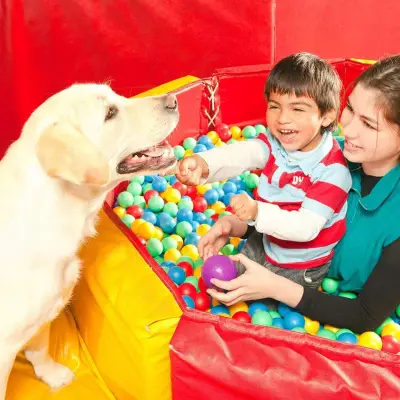Training your dog to speak can be a fun and rewarding experience. From getting them to bark on command to teaching a softer whisper bark, this skill will strengthen your bond with your dog and make communication clearer.
But how exactly do you teach a dog to speak, and is it a good idea to try? Let’s break down the process and find out how to train a dog to talk.
Jump to:
- What Does "Training a Dog to Speak" Actually Mean?
- Is it a Good Idea to Teach Your Dog to Speak?
- How to Train a Dog to Speak: The Step-by-Step Guide
- How to Teach a Dog to Whisper Bark
- How to Train a Dog to Stop Barking Excessively
- How Long Will It Take to Teach a Dog to Speak?
- Common Mistakes to Avoid
- Frequently Asked Questions
- Study Our Dog Training Diploma for £29
Recommended for you!
Best SellersWhat Does "Training a Dog to Speak" Actually Mean?
When you hear the phrase "training a dog to speak," it often refers to teaching your dog how to bark on command. This can range from a simple "speak" command that gets your dog to bark, to more advanced techniques where they can respond in specific ways, like whispering barks or even making a sound to indicate they need something. Some owners even train their dogs to speak in a way that mimics words, but that's more advanced. For now, we'll focus on the basics of how to teach a dog to bark on command.
Is it a Good Idea to Teach Your Dog to Speak?
Teaching a dog to speak can provide a fun way to engage with your dog, and it can also help with communication. With the right training, your dog will learn to respond only at certain times, which can make the behaviour more controlled and useful.
For example, if your dog barks a lot at the door, teaching them to bark on command could help you control the situation more effectively. On the other hand, if you're not interested in your dog barking excessively, this might not be the best trick for you.
How to Train a Dog to Speak: The Step-by-Step Guide

Step 1: Get Your Dog's Attention
Before you can teach your dog anything, start by calling their name, ensuring they focus on you. You can also use a favourite toy or treat to help capture their attention. Dogs are naturally curious, and with a little encouragement, they’ll be ready for what comes next.
Step 2: Identify the Trigger for Barking
To teach a dog to speak, it’s helpful to know when they’re most likely to bark naturally. Some dogs bark when excited, others when they see something outside, or when they want your attention. Observing your dog’s natural triggers will help you identify the best moments to introduce a command.
Step 3: Use a Cue Word
Pick a simple cue word such as “speak,” “talk,” or “bark.” Keep it consistent throughout the training process. When your dog starts to bark on their own, say the chosen word in a clear and calm voice, then reward them with a treat immediately after the bark. It’s important to reward them right away so they make the connection between the action and the reward.
Step 4: Practice and Repeat
As with any dog training, repetition is key. Continue to practice daily, offering the cue word when your dog barks, and reward them consistently. Over time, they’ll start to associate the cue with the action. Eventually, you’ll be able to use the cue word, and your dog will bark on command without needing a natural trigger.
Step 5: Introduce the Command in Different Settings
Once your dog has learned how to bark on command, it’s time to practice in different environments. Start by asking them to bark in different rooms, in the yard, and outside while on a walk. This helps your dog generalise the command, meaning they’ll be able to respond even when the surroundings change.
How to Teach a Dog to Whisper Bark

Some dog owners may want to teach their dog a softer bark, often referred to as a “whisper bark.” This method helps teach your dog to control the volume of their bark while still responding to the "speak" command.
- Master the Regular Bark First: Before introducing the whisper bark, ensure your dog has mastered barking on command.
- Introduce the Softer Bark: Once your dog is reliably barking on command, begin encouraging a quieter bark or whimper.
- Use the "Speak" Command: Ask for the "speak" command, but only reward your dog when they bark softly, rather than loudly.
- Reinforce the Softer Bark: Offer a treat or praise when your dog produces a softer bark to help them make the connection.
- Gradual Adjustment: Over time, your dog will understand the difference between a loud and soft bark, adjusting their response based on your cues.
How to Train a Dog to Stop Barking Excessively

If you're concerned about your dog barking excessively, teaching them when to bark is just as important as teaching them how to bark. A key part of dog training is helping your dog understand when barking is appropriate and when it’s not.
To prevent unwanted barking, you can introduce a "quiet" command. Once your dog starts barking on command, use the "quiet" command to get them to stop. When they stop barking, immediately reward them with a treat. Consistent training will teach them to switch between barking on command and being quiet when asked.
How Long Will It Take to Teach a Dog to Speak?
The timeline for teaching your dog to speak depends on their age, temperament, and previous training experience. Some dogs pick up new commands quickly, while others may take a little longer. Generally, with consistent training, most dogs can learn to speak within a week or two. Just remember that every dog is different, and patience is key.
Common Mistakes to Avoid
As you train your dog, there are a few common mistakes to watch out for:
- Inconsistent Training: If you don’t practice consistently, your dog might get confused and struggle to understand the command.
- Punishing Barking: Never punish your dog for barking. Instead, reinforce positive behaviour by rewarding the action you want to see.
- Overuse of Treats: While treats are a great reward, don’t rely on them too heavily. Gradually reduce the number of treats and replace them with praise and affection.
Recommended for you!
Best SellersFrequently Asked Questions
Can I teach an older dog to speak?
You can teach an older dog to speak, though it may take a little more time and patience. Older dogs may not learn as quickly as puppies, but with consistent practice and positive reinforcement, they can certainly pick up the skill.
How do I stop my dog from barking during training?
If your dog is barking excessively during training, remain calm and consistent. Use the "quiet" command to stop the barking, and reward your dog when they calm down. Keeping training sessions short and positive will also prevent frustration and over-excitement.
Can I teach my dog to speak without using treats?
While treats are a powerful motivator, they are not the only way to train your dog. You can use verbal praise, toys, or affection as rewards. However, in the beginning, treats are often the quickest way to reinforce the connection between the command and the action.
What if my dog doesn’t bark when I ask them to speak?
If your dog isn’t barking when you ask them to speak, be patient. Try to identify the right moment to introduce the command, such as when they naturally start barking. If that doesn’t work, you can gently encourage the behaviour by getting them excited or using a sound (like knocking on the door) that triggers barking, and then immediately use the command and reward them.
How do I know if my dog is ready to start learning this trick?
Your dog should be at least a few months old and capable of focusing on you during training. They should have basic obedience skills, such as responding to their name and being able to follow simple commands like "sit" or "stay." If your dog is easily distracted or seems overwhelmed, it may be best to work on other foundational skills first.
Is teaching my dog to speak safe?
Teaching your dog to speak is safe as long as you’re using positive reinforcement and not forcing them into uncomfortable situations. Ensure your training sessions are fun and encouraging, rather than stressful, and always avoid punishment-based methods.
Study Our Dog Training Diploma for £29
If you're enjoying the process of training your dog to speak and want to learn more about dog behaviour and training, consider enrolling in the Dog Training Diploma Course with Centre of Excellence. Right now, you can get this course for just £29!












